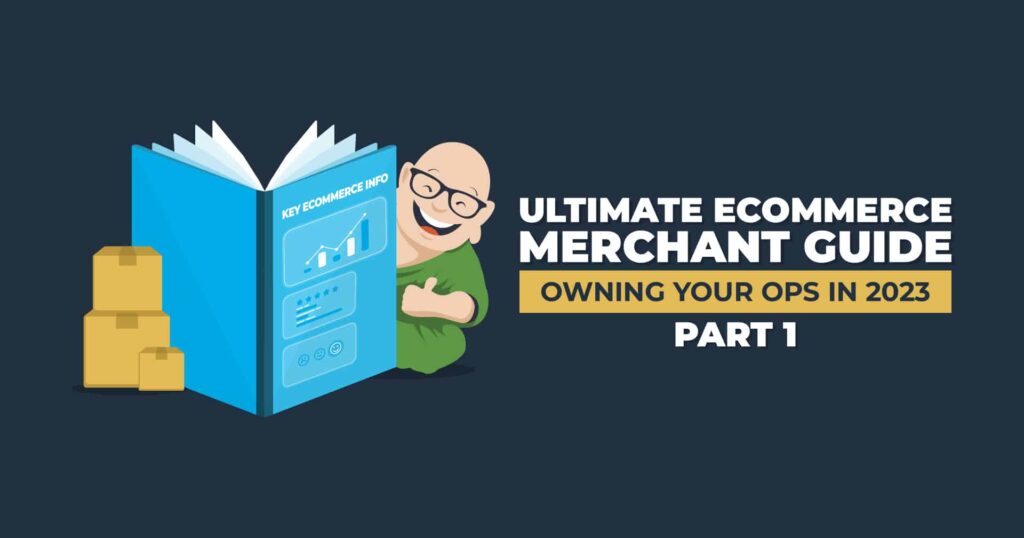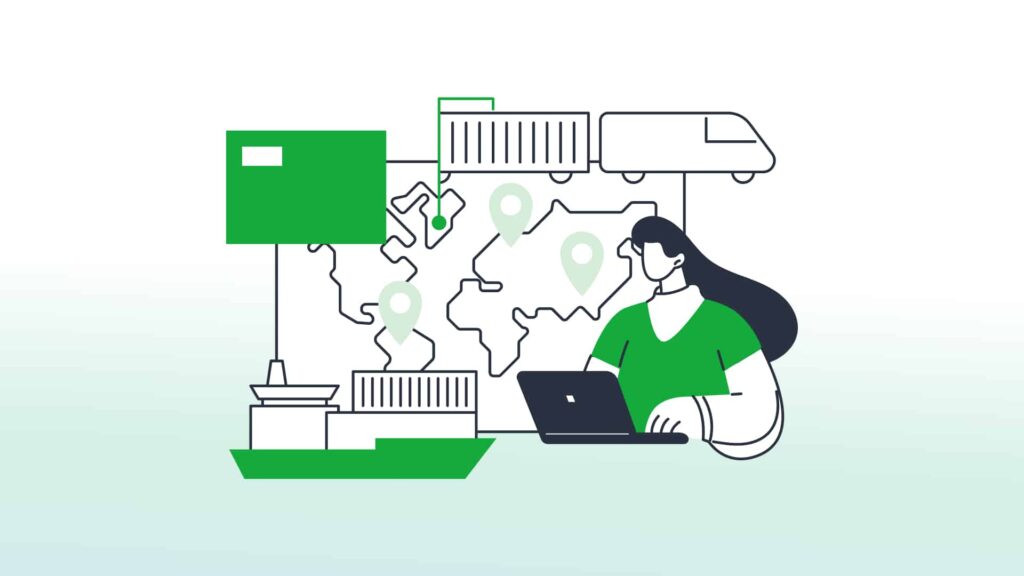Most folks in mainstream society are familiar with Auld Lang Syne—that old-timey New Year’s Eve song about reflection that plays every time the clock strikes midnight on December 31st. However, most people don’t know the majority of the lyrics to this classic; they just kind of go with it. While “going with it” is an acceptable strategy for some areas of the holidays; it’s not a strong plan for ecommerce brands during peak season.
Being at the top of the ecommerce game for peak season means understanding every aspect of inventory management, shipping, order fulfillment, delivery, claims, customer experience, and much, much more. And growing as an ecommerce brand throughout the year and for all future seasons requires reflection and understanding of the different facets of your previous peak season because this annual “pressure test” is great at exposing areas for improvement.
So heat up that cup of coffee, get comfortable, and delve into PART 1 of our Ultimate Ecommerce Merchant Guide outlining key areas that ecommerce merchants can learn from and build on this year and beyond!
Get Faster Shipping Options
Peak season is when ecommerce brands of all sizes across all verticals feel the most pressure to deliver on the delivery front. Whether that be offering free expedited shipping or providing an option where customers pay for the upgrade, having faster shipping options is pivotal to meeting customer expectations. If you encountered any customer backlash over the holidays because you did not provide faster shipping options, learn from that experience by offering more than just traditional ground or economy shipping going forward. 2-Day shipping, for example, is a great service you can provide to your customers!
Benefits of 2-Day Shipping
Overnight shipping is often too pricey for ecommerce merchants to offer for free, and too costly for ecommerce customers to upgrade to except in the case of emergencies. Therefore, 2-Day shipping is the next best thing in terms of hitting that sweet spot between overnight Flash-level speed and slow-and-steady economy shipping
But what is 2-Day shipping exactly? At a glance, this is when customers receive their ecommerce orders within two days of purchase, assuming they click BUY before a specific cutoff time on a specific day. A lot goes into those two days, including picking, packing, shipping, and delivery of ordered product(s). Policies for 2-Day shipping can change depending on if an ecommerce brand uses a flat or business 2-day policy.
Regardless of the specifics, if you want your ecommerce business to lessen customer backlash on shipping speed during peak season, and want to stay competitive in 2023, 2-Day shipping is where it’s at for customer satisfaction. With the 2-Day shipping options that ShipMonk offers, overall you can:
1.) Reduce Cart Abandonment
2.) Increase Customer Satisfaction and Loyalty
3.) Expand Your Seller Talking Points
Discover the full benefits of 2-Day shipping now. We are passionate about offering ecommerce brands fulfillment and shipping solutions that have multifaceted benefits like this!
Learn to Calculate Reorder Points
Did you run out of inventory during peak season? Did you misorder certain SKUs leaving you with too much of one item and not enough of another? Have you had to disappoint holiday shoppers with backorders, delayed backorders, or stockouts? If you answered yes to any of these questions then you could benefit from learning to better calculate reorder points.
What is a Reorder Point?
A reorder point (ROP) is a predetermined minimum number of units for each SKU that, when reached, triggers an order for more. Learning how to calculate reorder points for your assorted products helps ensure that you always have enough inventory on hand to meet demand, while minimizing inventory costs or rush costs on shipping from manufacturer to fulfillment center.
To calculate a reorder point you’ll need to be able to calculate a couple other key formulas first: Demand During Lead Time and Safety stock. Our full ecommerce article on calculating reorder points has in-depth descriptions for gathering the data you need for these formulas. Once you have that info, calculating reorder points is easy with the below equation:
So don’t wait; and don’t dwell on any inventory pitfalls of last peak season. That was 2022 and we’re in 2023. You can learn, improve, and push forward with fabulous reorder point formulas to minimize warehouse or fulfillment center storage costs, improve demand forecasting and inventory management, and enhance your entire operation with accuracy and preparedness.
Make Sure You Have Safety Stock
People in life may tell you to play it safe. While risk-taking can be beneficial, and doing so shrewdly can be the sign of a true entrepreneur, “play it safe” is still good advice in some areas like skydiving, eating street food, and ordering stock around peak season. Hence the term “safety stock.”
Safety stock is extra inventory you keep on hand to fill orders during an unexpected surge in demand or a supply chain delay. Naturally, you don’t want to waste money paying your fulfillment center to carry too much inventory though, which leads us to the formula for calculating an ideal number of units to keep in stock for each SKU.
How to Calculate Safety Stock
The concise version: calculate the difference between your worst-case supply/demand scenario and your average scenario. The info you’ll need for that is:
- Maximum Daily Orders
- Maximum Lead Time
- Average Daily Orders
- Average Lead Time
Gather all that data, then you can use the below formula to figure out the recommended number of units your ecommerce brand should keep for safety stock. If you do that then you’ll be in a much better place for managing inventory spikes and supply/demand fluctuations in the future. Because, while supplier problems are out of your control, maintaining the right safety stock to minimize damage to your reputation and ecommerce business are most definitely within your control.
Summing that up, here’s a bonus formula for you to chew on:
Adequate Safety Stock + Keeping Your Eye on Evolving Data = Minimal Backorders, Less Stockouts, and Fewer Upset Customers
Refamiliarize Yourself with Factors That Affect Shipping
Shipping can be complex, costly, and just plain cray-cray. At ShipMonk, we apply a variety of shipping solutions to simplify our ecommerce clients’ processes and help them save money, time, and stress. For example, our 3PL fulfillment platform and Virtual Carrier Network. If you dealt with any shipping dilemmas during peak season, we recommend familiarizing yourself with both of these unique fulfillment solutions that ShipMonk offers. Additionally, it is vital that you refamiliarize yourself with the six main areas that affect shipping so you can understand how our fulfillment solutions help AND make better decisions for the coming year. The six main factors that influence shipping are:
1. Shipping Zones (how far it has to go)
Major shipping carriers use shipping zones to determine the shipping cost of an ecommerce order. The United States, for example, is broken down into Zones 1 – 8 for domestic shipments (grouped by zip codes, not mileage, from package point of origin to point of destination. Learn more about how shipping zones work, and how they affect shipping cost and delivery time to save money and enhance customer satisfaction in 2023 and beyond.
2. Weight (actual weight in pounds)
A general rule of thumb is that the larger and/or heavier a package is, the more it costs to send. Major shipping carriers periodically increase their pricing structures every year to account for inflation, peak season, surcharges, and other supply chain fluctuations. A key element that affects pricing consistently is the number of shipping zones an ecommerce order has to travel. The sample table from USPS Commercial – Priority Mail below illustrates how shipping cost increases from zone to zone are smaller for lighter packages while shipping costs go up more significantly zone by zone if you’re shipping heavy items.
| Weight | Zones 1 & 2 | Zone 3 | Zone 4 | Zone 5 | Zone 6 | Zone 7 | Zone 8 | Zone 9 |
| 1lb | $9.00 | $9.40 | $9.75 | $10.85 | $11.15 | $11.90 | $12.60 | $20.40 |
| 2lbs | $9.55 | $10.20 | $11.00 | $12.75 | $13.65 | $15.75 | $17.10 | $31.75 |
| 3lbs | $10.20 | $10.95 | $12.05 | $14.70 | $16.40 | $18.90 | $22.20 | $42.15 |
| 4lbs | $10.85 | $11.70 | $12.75 | $15.95 | $19.30 | $22.60 | $25.05 | $48.65 |
| 5lbs | $11.55 | $12.50 | $13.45 | $16.75 | $21.35 | $25.80 | $28.75 | $56.15 |
3. Dimensional Weight (a formula involving size and weight)
Shipping carriers (FedEx, UPS, USPS, DHL, and so on) charge customers for two things: their services and physical space in their trucks, planes, etc. The more packages they can fit into a trailer or cargo hold, the more money they’ll make on a trip across the country. Hence the use of dimensional weight as a cost determining factor.
Dimensional weight (DIM weight or volumetric weight) charges for the volume (cubic inches per pound) a package takes up. The more space, the more you—the ecommerce merchant—is going to pay. So how exactly do shipping carriers calculate DIM weight?
It’s pretty simple; your shipping carrier will weigh the package and then measure all three dimensions at their largest points, rounding up each number to the nearest inch. Once all those metrics are taken, it’s a matter of width x length x height, followed by dividing that number by the DIM factor (sometimes called the “DIM divisor” or “density ratio”). The result is the DIM weight. But what the heck is the DIM factor?
To ensure profitability, each shipping carrier sets its own DIM factor, or the maximum cubic inches per pound they will accept. Because this number is the divisor in the equation above, the higher the DIM factor, the lower the DIM weight. Some carriers (like UPS) will charge their regular ecommerce business customers one rate, and infrequent customers a different rate. Additionally, because space and weight limitations vary between air, freight, ocean, rail, road, etc., some shipping carriers (like DHL) use a different DIM factor for each mode of transportation.
4. Methods of Transportation (how the package is getting there)
There are two dominant delivery service options: air shipping and ground shipping. Air shipping (i.e. cargo shipping via airplane) is significantly more expensive, but the fastest way to transport goods across shipping zones. It is a better budget option to ship orders in bulk vs. individual items.
Ground shipping uses trucks, vans, and/or cars to transport ecommerce orders. Ground shipping is used for shorter distances, i.e. orders going to customers within the same zone as the fulfillment center or warehouse they’re coming from. 3PLs like ShipMonk make it much easier to ship a package utilizing minimal zones thanks to our many state-of-the-art fulfillment centers.
5. Surcharges (because sometimes things cost extra)
There are a number of reasons why a shipping carrier could increase the costs of sending packages. The main surcharges to be aware of are:
- Delivery Area Surcharges (DAS) and Extended Delivery Area Surcharges (EDAS) that apply to shipments made to and from locations in remote areas
- Peak season surcharges when the holiday shopping season arrives—most, if not all of the major shipping carriers applied peak season surcharges.
- Fuel surcharges—which are always present regardless of fuel cost, but are adjusted throughout the year based on changing fuel costs as other charges may or may not be implemented.
If your ecommerce brand was a victim of costly surcharges that hurt your bottom line during peak season, now is definitely the time to look into ShipMonk 3PL services. Because in addition to order fulfillment, inventory management, and warehouse management advances, our Virtual Carrier Network allows us to standardize the common surcharges that ecommerce merchants face. In other words, you don’t pay a different price, and don’t face an array of surcharges when rate shopping based on the major shipping carrier you use. How’s that for saving you money?
6. Speed (how fast you deliver)
A huge part of making ecommerce customers happy is swift turnaround time a.k.a. how quickly an ecommerce order reaches a customer’s front door. Naturally, an ecommerce business needs to balance happy customers with happy margins, so take all previously mentioned shipping aspects into consideration when you’re offering speedier shipping options (overnight shipping, 2-Day shipping, etc.). And if you’re looking for an affordable way to implement 2-day shipping, here are a few solutions that ecommerce merchants can apply to keep up with competitors and shoppers expectations while balancing budget.
1.) Build the cost of that speed into the pricing of your products.
2.) Offer it only to loyal buyers or people with memberships.
3.) Give customers the option to pay for the upgrade themselves.
4.) Set a minimum spend threshold to earn the faster shipping option.
If You Don’t Have Tracking Systems, Get Them
Tracking systems are invaluable, as they allow ecommerce merchants and their end customers to follow the shipping progress of their packages. Most of your customers expect to be able to track their packages, and the added costs of supporting inbound support requests takes its toll. So not offering some form of tracking can result in a negative customer experience and wasted man hours for your team, especially if delivery is delayed. And in the case of peak season when items can get lost or delayed frequently due to supply chain strain, this matters A LOT.
If you don’t have real-time, extremely responsive delivery status notifications and other ways for ecommerce customers to check on their orders, get some now that work hand-in-hand with your barcodes, SKUs, etc. That way you and your buyers are fully aware of all notifications. Whether the notification is just a simple update, an alert of a delivery exception, or a request for reshipment, everyone will be in the loop.
Proof of Delivery
A ton can happen during an ecommerce order’s journey from fulfillment center to front door. To ensure everything is on the up and up, you—the ecommerce merchant—can request proof of delivery, such as a signature or a photo taken of the item when it arrives at your customer’s door. While this won’t prevent theft, it does prove that the package was delivered and may reduce fraudulent claims.
Branded Tracking
The average customer checks the status of an order 7 times. Tracking numbers can be linked to an app, to a shipping carrier’s website, or to your ecommerce brand’s website. ShipMonk offers a service called MonkProtect™ where customers can opt-in to get delivery protection on their orders for theft, loss, or damage.
MonkProtect also enables merchants to host the order-tracking function and claims processing on their own branded websites. So instead of sending customers to FedEx or UPS, your ecommerce brand can take advantage of those 7 views by promoting sales, seasonal promos, secondary purchases, loyalty plans, and referral discounts. Sounds like a win-win solution to peak season tracking problems, no?
Protect the Ship Out of Your Orders
At peak season, all sorts of items are getting shipped to all sorts of places. If you had any unhappy customers during that time frame specifically due to lost, damaged, or stolen goods, it’s time to reevaluate how you protect your orders.
First there’s the obvious area to look into: dunnage. As in, are you using the right protective materials, bubble wrap, packing peanuts, or other lightweight fill to package your items? Second, protection in terms of insurance. If you ship fragile or expensive items, it makes sense to include additional protection in your shipping charges, or offer it to your customers as an add-on option at checkout. Separate from 3PLs, shipping carriers have their own policies regarding liability. Be sure to do your own research on this depending on the kind of shipping service you paid for, and the package you’re sending. Third, if you work with ShipMonk, consider utilizing our post-purchase suite MonkProtect.
MonkProtect
With the MonkProtect post-purchase suite, ecommerce customers can opt in at checkout for delivery protection (pertaining to theft, loss, or damage) on their packages starting at $0.97/order. If they need to file a claim, they can do so online and get instant reassurance that the claim is being processed. Status notifications keep customers updated and satisfied from start to finish. Meanwhile, on the ecommerce merchant’s side, claims are centralized and automatically pushed for approval, reshipment, and/or reimbursement—making the whole process 10x faster than manual claims processing.
Learn, Grow, Repeat
The hallmark of any success story is the ability to adapt and overcome. The hallmark of any business success story is that, PLUS learning quickly so you can survive, thrive, and continuously convince customers to choose you over competitors.
We hope that PART 1 of this Ultimate Ecommerce Merchant Guide will help you as you plan your ops strategy for 2023, and all the great years that come after. To work with a team of 3PL experts that helps you get to “great” faster, contact ShipMonk today. And discover more key lessons your ecommerce business can learn and grow from in PART 2 of our guide coming soon!





